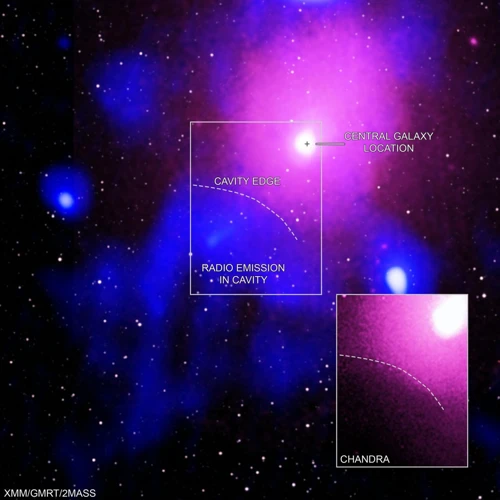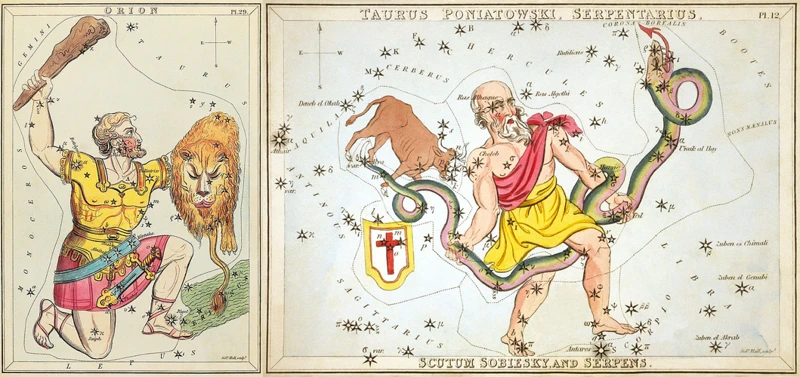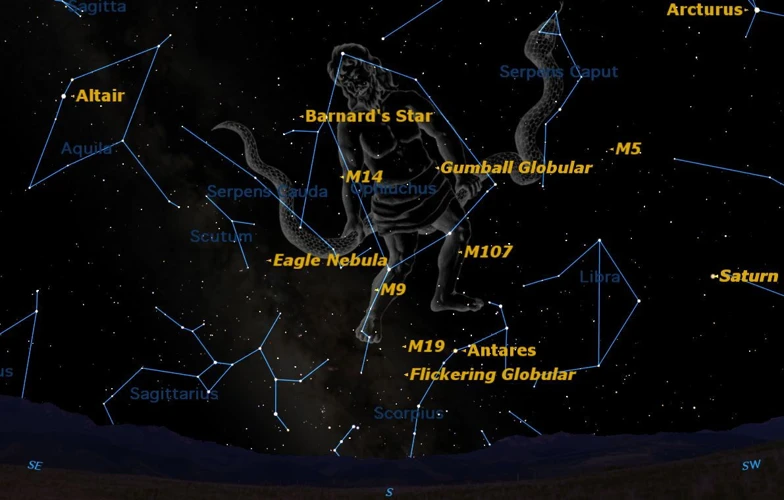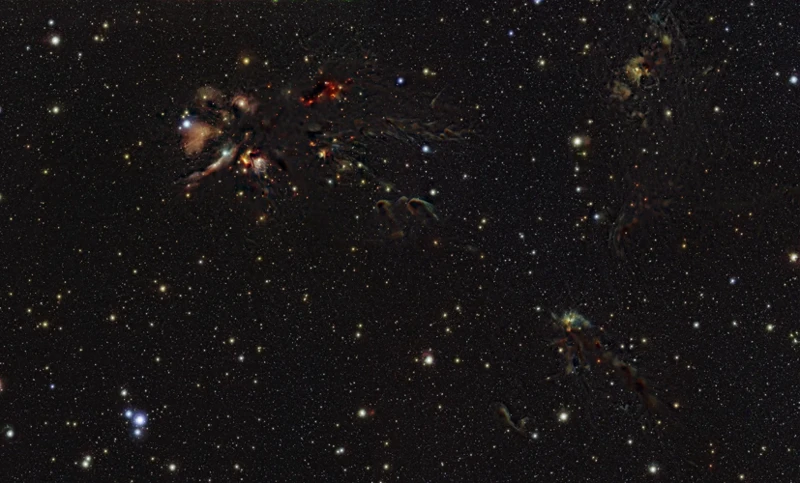The Ophiuchus constellation has long been a subject of fascination and intrigue in the world of astronomy. Its unique position in the night sky, intertwined with myths and legends, has captivated stargazers throughout history. From ancient references to its modern discovery, Ophiuchus has a rich and mysterious past. In this article, we will take a closer look at the characteristics of Ophiuchus, explore its mythology and legends, uncover interesting facts about this rarely seen constellation, and delve into the stars that make up its celestial wonders. Join us as we journey through the cosmos and unravel the secrets of the Ophiuchus constellation.
Contents
- A Brief History
- Characteristics of Ophiuchus
- Mythology and Legends
- Interesting Facts about Ophiuchus
- Exploring the Stars in Ophiuchus
- Conclusion
-
Frequently Asked Questions
- 1. What is the significance of the Ophiuchus constellation?
- 2. Why is Ophiuchus sometimes considered the 13th zodiac sign?
- 3. Is Ophiuchus a visible constellation?
- 4. What is the Ophiuchid meteor shower?
- 5. What are some notable stars in the Ophiuchus constellation?
- 6. Does Ophiuchus have any connection to serpent symbolism?
- 7. Is there evidence of the Ophiuchus constellation in ancient cultures?
- 8. Can the Ophiuchus constellation be seen from both hemispheres?
- 9. Are there any planets or exoplanets discovered in the Ophiuchus constellation?
- 10. Is it possible to explore the stars in the Ophiuchus constellation through a telescope?
- References
-
Frequently Asked Questions
- 1. What is the meaning of the Ophiuchus constellation?
- 2. Is Ophiuchus considered a part of the zodiac?
- 3. How big is the Ophiuchus constellation?
- 4. Are there any notable stars in Ophiuchus?
- 5. Can the Ophiuchus constellation be seen with the naked eye?
- 6. What is the significance of Ophiuchus in astrology?
- 7. How often does the Ophiuchid meteor shower occur?
- 8. What is the story behind Asclepius, the Healer?
- 9. Why is the Ophiuchus constellation rarely seen?
- 10. Could the Ophiuchus constellation be the missing link in astrology?
- References
- Read More
A Brief History

The history of the Ophiuchus constellation is steeped in ancient references and modern discoveries. In ancient times, this celestial figure was revered and identified with significant symbols. The constellation’s association with healing and medicine can be traced back to Asclepius, the Greek god of medicine. In the 17th century, the Ophiuchus constellation was rediscovered by the modern astronomers, solidifying its place in the cosmic map. Interestingly, there has been controversy surrounding the inclusion of Ophiuchus as the 13th zodiac sign, which has had an impact on astrological charts. To delve deeper into the fascinating history of the Ophiuchus constellation, let’s explore its ancient references and uncover the modern discoveries that have shaped our understanding of this celestial wonder.
1. Ancient References
In ancient references, the Ophiuchus constellation held great significance and was associated with various symbols and mythologies. In Greek mythology, the constellation was linked to Asclepius, the god of healing and medicine. Asclepius was known for his ability to resurrect the dead and was often depicted holding a serpent-entwined staff, known as the Rod of Asclepius. This association with serpents has carried over into the symbolism of the Ophiuchus constellation itself, as it is depicted as a man holding a snake. Additionally, in Egyptian mythology, the constellation was linked to Imhotep, a deity associated with medicine, healing, and wisdom. In ancient cultures across the world, celestial phenomena like the movement of planets and alignments of stars were believed to have an impact on human affairs. The alignment of Ophiuchus with certain planets and celestial events was believed to have spiritual and astrological significance. These ancient references highlight the rich history and cultural importance of the Ophiuchus constellation throughout the ages.
2. Modern Discovery
Modern astronomers played a crucial role in the rediscovery of the Ophiuchus constellation. While the ancient references to Ophiuchus were known, it was not until the 17th century that its celestial significance was fully recognized. The constellation was officially added to the modern list of 88 constellations compiled by the International Astronomical Union (IAU), solidifying its place among the stars. This discovery was made possible through advancements in telescopes and stargazing techniques, allowing astronomers to identify and map celestial objects with greater accuracy. The inclusion of Ophiuchus as a recognized constellation has sparked debates and controversies, particularly in the field of astrology. Some argue that it should be considered as the 13th zodiac sign, impacting astrological charts and interpretations. However, it is important to note that the IAU does not recognize Ophiuchus as a zodiac sign. Nonetheless, the modern discovery of Ophiuchus has added another layer of intrigue to the study of the cosmos. To learn more about the impact of Ophiuchus on astrological charts, read our article on the symbolic influence of Ophiuchus in astrological charts.
Characteristics of Ophiuchus

The Ophiuchus constellation possesses unique characteristics that set it apart in the night sky. Positioned near the celestial equator, Ophiuchus is one of the larger constellations, spanning a vast area. Its prominent stars, such as Rasalhague (Alpha Ophiuchi) and Yed Prior (Delta Ophiuchi), shine brightly, captivating astronomers and stargazers alike. However, the most intriguing aspect of Ophiuchus lies in its connection to the zodiac. Due to its position on the ecliptic, Ophiuchus has sparked controversy regarding its status as the 13th zodiac sign. This controversy has had significant implications for astrological charts, challenging the traditional understanding of the zodiac system. To explore further the position and size of Ophiuchus, as well as its notable stars and its impact on the zodiac, let’s take a closer look at the captivating characteristics of this celestial wonder.
1. Position and Size
Position and Size:
– The Ophiuchus constellation is located near the celestial equator, making it visible from both the northern and southern hemispheres. Its approximate coordinates range from 9 to 16 hours of right ascension and 0 to 20 degrees of declination. Ophiuchus lies between the constellations of Scorpius and Sagittarius in the zodiacal region of the sky.
– In terms of size, Ophiuchus is the 11th largest constellation, spanning an area of about 948 square degrees. This makes it larger than familiar constellations such as Orion and Taurus. Within its boundaries, Ophiuchus contains numerous stars, deep-sky objects, and galaxies that offer a wealth of exploration opportunities for astronomers and stargazers alike. It is a captivating sight in the night sky, with its distinct shape and neighboring constellations adding to its beauty and allure.
– The positioning and size of Ophiuchus have played significant roles in various cultures and ancient civilizations. In ancient Egyptian astrology, the constellation was associated with the deity Imhotep, who was revered as a healer and physician. The celestial position of Ophiuchus also holds symbolism and meanings in other ancient cultures, highlighting the deep connection between the celestial realm and human beliefs and interpretations. To learn more about the symbolism of celestial alignments in ancient cultures, visit this link.
– It’s worth noting that while Ophiuchus has captured the interest of researchers and astronomers, it is not as widely recognized as other constellations due to its position near the ecliptic. Nevertheless, its unique characteristics and significance in astronomy make it a fascinating constellation to explore. Additionally, Ophiuchus holds no direct associations with black holes, unlike other celestial bodies. To learn more about the different types of black holes, you can refer to our article on types of black holes.
2. Notable Stars
When it comes to the notable stars in the Ophiuchus constellation, there are several dazzling celestial bodies that stand out. One of the most prominent stars is Rasalhague, also known as Alpha Ophiuchi, which shines with a bluish-white brilliance. This binary star system consists of a primary star and a companion star, and it is located approximately 47 light-years away from Earth. Another noteworthy star is Yed Prior, also known as Delta Ophiuchi, which appears yellow in color. Yed Prior is a binary star system as well, composed of two stars orbiting each other. Moving on, we have Theta Ophiuchi, a triple star system that forms a stunning visual triple star with its three components. These stars collectively create a beautiful contrast in colors, with one star appearing blue, one white, and one yellow. Additionally, the Ophiuchus constellation is also home to two notable star clusters, M10 and M12. These globular clusters contain a dense collection of stars and can be observed with binoculars or telescopes. Lastly, we have Barnard’s Star, a red dwarf located about 5.9 light-years away from Earth. It is one of the closest known stars to our Solar System and is notable for its high proper motion. These notable stars and star clusters in the Ophiuchus constellation add to its celestial beauty and allure, providing stargazers with captivating sights to explore in the night sky.
3. Zodiac Sign Controversy
The Ophiuchus constellation has sparked controversy in the world of astrology due to its potential status as the 13th zodiac sign. According to ancient Babylonian astrology, the zodiac was divided into 12 equal parts, each represented by a specific constellation. However, the inclusion of Ophiuchus disrupts this system and raises questions about the traditional zodiac calendar. Ophiuchus is positioned between Scorpio and Sagittarius, leading some astrologers to suggest that individuals born between November 29 and December 17 should belong to this additional zodiac sign. This controversy has stirred debate among enthusiasts, with some embracing Ophiuchus as a legitimate astrological sign, while others argue against its inclusion. Proponents of Ophiuchus claim that its influence brings traits such as wisdom, healing, and intuition. However, skeptics argue that astrology should adhere to the traditional 12 zodiac signs and that incorporating Ophiuchus would disrupt the existing astrological symbolism. Regardless of the controversy, it is evident that the topic of Ophiuchus as a zodiac sign remains a point of contention within the astrological community.
Mythology and Legends

Mythology and legends surrounding the Ophiuchus constellation add an extra layer of enchantment to its celestial presence. One prominent figure in the mythology of Ophiuchus is Asclepius, a skilled healer in Greek mythology. Asclepius is often depicted holding a staff with a serpent coiled around it, a symbol associated with the constellation. The serpent symbolism is deeply rooted in various cultures, representing transformation, rebirth, and wisdom. The influence of Ophiuchus extends to astrology, where debates and discussions have arisen regarding its impact on astrological charts and the possibility of it being the true 13th zodiac sign. By exploring the mythology and legends surrounding Ophiuchus, we gain a deeper appreciation for the intricate connections between the celestial realms and human beliefs.
1. Asclepius, the Healer
Asclepius, the Healer, plays a significant role in the mythology and legends surrounding the Ophiuchus constellation. In Greek mythology, Asclepius was a demigod known for his exceptional healing abilities. He was the son of Apollo, the god of medicine, and a mortal woman named Coronis. Raised by the wise centaur Chiron, Asclepius became a skilled physician, surpassing all others in the field of medicine. His symbol, the Rod of Asclepius, is often associated with the medical profession to this day. According to myth, Asclepius had the power to resurrect the dead through his healing arts. However, this ability disrupted the natural order of life and death, leading to consequences. Zeus, the king of the gods, struck him down with a thunderbolt, but later honored Asclepius by placing him among the stars as the Ophiuchus constellation. This celestial placement symbolizes the healing and restorative powers that Asclepius possessed. It serves as a reminder of the importance of medicine and the pursuit of healing arts throughout history.
2. Serpent Symbolism
Serpent symbolism plays a significant role in the mythology and legends surrounding the Ophiuchus constellation. The image of the serpent intertwines with the figure of Ophiuchus, representing its strong connection to healing and transformation. In ancient cultures, snakes were regarded as symbols of wisdom, rebirth, and immortality. In Greek mythology, Ophiuchus is associated with the god Asclepius, who is often depicted holding a staff with a serpent wrapped around it, known as the Rod of Asclepius. This symbol, which is still used today in medical and healing professions, illustrates the link between Ophiuchus, healing, and the serpent. The serpent’s shedding of its skin also represents the concept of transformation and renewal, reflecting Ophiuchus’ ability to bring about healing and change. The serpent symbolism thus adds a layer of mystique and power to the Ophiuchus constellation, making it an intriguing subject for astronomers, astrologers, and myth enthusiasts alike.
3. Influence on Astrology
The Ophiuchus constellation has had a significant influence on astrology, sparking debates and discussions among enthusiasts and practitioners. Traditionally, zodiac signs were divided into twelve, each corresponding to a specific period of the year. However, the inclusion of Ophiuchus as the 13th zodiac sign has presented a new perspective on astrological interpretations. With its association to healing and medicine, Ophiuchus symbolizes a potential shift in astrological charts and characteristics. Individuals born under this sign are said to possess traits such as intuition, wisdom, and a drive for personal growth. Some astrologers argue for the inclusion of Ophiuchus as a way to provide a more comprehensive view of an individual’s horoscope and personality. While its influence in astrology is still a topic of debate and exploration, the presence of Ophiuchus adds an intriguing dimension to the world of astrology, encouraging further examination and interpretation.
Interesting Facts about Ophiuchus

Ophiuchus, the serpent bearer, holds a myriad of interesting facts that add to its enigmatic nature. First and foremost, this constellation is rarely seen due to its placement just below the ecliptic. Despite its hidden existence, Ophiuchus holds a clue to the existence of a 13th zodiac sign, igniting debates and discussions among astrologers and enthusiasts. Additionally, Ophiuchus is associated with a unique meteor shower known as the Ophiuchid meteor shower, which occurs in early May and late June. This meteor shower provides a breathtaking celestial display, captivating those fortunate enough to witness it. These intriguing facts shed light on the captivating beauty and secrets hidden within the confines of the Ophiuchus constellation.
1. Rarely Seen Constellation
The Ophiuchus constellation is often considered a rarely seen constellation, which adds to its mystique and allure. Unlike some of the more prominent constellations in the night sky, Ophiuchus is not as well-known or easily recognizable. One of the reasons for its infrequent sightings is its location near the celestial equator. This means that it can only be seen during specific times of the year and from certain latitudes. Additionally, Ophiuchus is situated between the constellations of Scorpius and Sagittarius, which are both bright and captivating. This can make it more challenging to spot Ophiuchus amidst the celestial splendor. However, with a keen eye and clear conditions, stargazers can get a glimpse of this elusive constellation and marvel at its unique beauty.
2. Clue to the 13th Zodiac Sign
The Ophiuchus constellation has sparked debate and controversy in the realm of astrology due to its potential connection to the concept of a 13th zodiac sign. Traditionally, the zodiac consists of 12 signs, each corresponding to a specific time period of the year. However, the alignment of the Earth’s axis has shifted over time, leading some to speculate that a 13th zodiac sign should exist. Ophiuchus, with its position on the celestial equator, has been identified as a possible candidate for this additional sign. Those who advocate for the inclusion of Ophiuchus argue that it represents a time period between November 30th and December 17th. This notion has led to discussions about the implications for personal horoscopes and astrological interpretations. While the debate over the 13th zodiac sign remains unresolved in the astrological community, Ophiuchus continues to captivate the imagination as a potential clue to a larger cosmic puzzle.
3. Ophiuchid Meteor Shower
The Ophiuchid Meteor Shower is a celestial phenomenon that occurs annually, usually from mid-November to early December. This meteor shower is associated with the debris left behind by the comet 26P/Grigg-Skjellerup. Although not as well-known as some other meteor showers, the Ophiuchid Meteor Shower offers a spectacular display of shooting stars for those who are lucky enough to witness it.
During the peak of the shower, observers can expect to see around ten meteors per hour, with occasional outbursts that can increase the rate to as many as 50 meteors per hour. The meteors appear to radiate from the vicinity of the Ophiuchus constellation, particularly from its head and neck regions. To have the best chance of spotting these meteors, it is advisable to find a dark location away from city lights and to look towards the southeastern sky.
The Ophiuchid Meteor Shower is known for its long-lasting meteors that produce beautiful fireballs, creating a truly mesmerizing display. While it may not be as popular as other meteor showers, such as the Perseids or the Geminids, the Ophiuchid Meteor Shower offers astronomy enthusiasts a unique and captivating experience. So, mark your calendars and make sure to keep an eye out for this dazzling celestial event in the skies above.
Here is a table summarizing some key details about the Ophiuchid Meteor Shower:
| Annual Occurrence | Mid-November to Early December |
|---|---|
| Associated Comet | 26P/Grigg-Skjellerup |
| Peak Activity | Variable, with occasional outbursts |
| Hourly Rate | Average of 10 meteors per hour, but can increase to 50 meteors per hour during outbursts |
| Radiant Point | Near the head and neck regions of the Ophiuchus constellation |
Exploring the Stars in Ophiuchus

Exploring the stars in the Ophiuchus constellation is a mesmerizing journey through celestial wonders. One standout star is Rasalhague, also known as Alpha Ophiuchi. This bright giant star is located near the head of Ophiuchus and is notable for its bluish tint. Another intriguing star is Yed Prior, also known as Delta Ophiuchi, which shines with a golden yellow hue. Theta Ophiuchi, on the other hand, is a binary star system where two stars orbit each other, creating a stunning visual spectacle. Moving towards globular clusters, stargazers can marvel at M10 and M12, two magnificent clusters containing thousands of stars. Lastly, Barnard’s Star, a nearby red dwarf, is the fourth closest known individual star to our solar system. Each of these stars holds its own allure and allure and offers an opportunity to delve further into the beauty of the Ophiuchus constellation.
1. Rasalhague (Alpha Ophiuchi)
Rasalhague, also known as Alpha Ophiuchi, is one of the most prominent stars in the Ophiuchus constellation. It holds a special place in the night sky, captivating astronomers and stargazers alike. This majestic star is classified as a binary star system, comprised of a primary star and a companion star. The primary star, Rasalhague A, is a blue-white giant, shining with a luminosity over 200 times that of our Sun. It boasts a diameter approximately 70 times larger than the Sun and a surface temperature of around 8,500 degrees Celsius. Its companion star, Rasalhague B, is a smaller and dimmer yellow dwarf. The distance between these two stars is about 67 astronomical units. Rasalhague is approximately 48 light-years away from Earth.
In addition to its physical characteristics, Rasalhague holds significance in the realm of astrology. Its name comes from the Arabic term for “the head of the snake handler.” In ancient Babylonian and Greek cultures, Ophiuchus was often depicted as a snake handler, and Rasalhague represented the head of the serpent. This star is also a member of the Ophiuchids, a meteor shower associated with the Ophiuchus constellation that occurs annually in mid-June.
Rasalhague has been the subject of scientific research and observation. Its brightness and proximity make it a fascinating target for astronomers studying stellar evolution and binary star systems. Its unique properties and celestial presence contribute to the allure and mystique of the Ophiuchus constellation, inviting us to gaze up at the night sky and wonder at the vastness of the universe.
Sources:
- Symbolism and Planetary Alignments in Ancient Cultures
- The Symbolic Impact of Ophiuchus in Astrological Charts
2. Yed Prior (Delta Ophiuchi)
Yed Prior, also known as Delta Ophiuchi, is one of the prominent stars in the Ophiuchus constellation. It is a binary star system located approximately 170 light-years away from Earth. Yed Prior is easily identifiable due to its distinctive yellowish color and its position as the brightest star in the constellation. The primary star in this system is a subgiant star, which means it is transitioning from the main sequence phase to becoming a red giant. This star is estimated to be about eight times the size of our Sun and shines with a luminosity over 40 times greater. The secondary star is a smaller companion star, which orbits the primary star at a considerable distance. The two stars complete an orbit around each other over a period of about 20 years. Yed Prior also has an apparent magnitude that varies slightly, indicating its subtle pulsations. These pulsations provide valuable insights into stellar astrophysics. With its unique characteristics and prominent position in the Ophiuchus constellation, Yed Prior is a fascinating star that captures the attention of astronomers and stargazers alike.
3. Theta Ophiuchi
Theta Ophiuchi, also known as θ Ophiuchi, is a captivating star within the Ophiuchus constellation. It is part of a multiple star system, consisting of three stars, with Theta Ophiuchi A being the primary component. This star system is located approximately 96 light-years away from Earth. Theta Ophiuchi A is a massive blue-white star, classified as a B2 V main-sequence star. Its luminosity, which is about 160 times that of the Sun, makes it shine brilliantly in the night sky. Theta Ophiuchi has a companion star, Theta Ophiuchi B, which is a dimmer star located fairly close to the primary star. These two stars have an orbital period of nearly 69 years. There is also a third companion star, Theta Ophiuchi C, which is located much farther away from the primary star and has a longer orbital period of around 525 years. The combination of these three stars makes Theta Ophiuchi a fascinating and complex system to observe. As one gazes up at the night sky, Theta Ophiuchi stands as a shining example of the celestial wonders within the Ophiuchus constellation.
4. M10 and M12
M10 and M12 are two remarkable globular clusters located within the constellation of Ophiuchus. These clusters are perfect examples of the celestial beauty that can be found within this constellation.
M10, also known as NGC 6254, is a bright and compact globular cluster. It is estimated to be around 15,000 light-years away from Earth, making it one of the closest globular clusters to our solar system. With an apparent magnitude of 6.6, it is easily visible with binoculars or a small telescope. M10 is densely packed with hundreds of thousands of stars, and its core shines particularly bright, surrounded by a halo of fainter stars.
M12, or NGC 6218, is another stunning globular cluster in Ophiuchus. It is located at a distance of approximately 15,700 light-years from Earth. With a slightly higher apparent magnitude of 6.7, M12 is also easily visible with binoculars or a telescope. This cluster is slightly more loose in structure compared to M10, with its stars spread out over a larger area. The stars in M12 form a beautiful spherical shape, and their combined light creates a mesmerizing glow.
Both M10 and M12 are considered to be old globular clusters, with ages estimated to be around 12-13 billion years old. These clusters contain a mix of stars, from older, cooler ones to younger, hotter ones. Their ages and compositions provide valuable insights into the early universe and the formation of stars.
Exploring M10 and M12 is a rewarding experience for astronomy enthusiasts. Observing these clusters allows us to appreciate the vastness of the cosmos and marvel at the intricate structures and beauty found within the Ophiuchus constellation.
5. Barnard’s Star
5. Barnard’s Star
Conclusion

In conclusion, the Ophiuchus constellation is a captivating and enigmatic part of the night sky. From its ancient references to its modern discovery, the history of Ophiuchus showcases its significance in various cultures and scientific advancements. Its unique position and size make it a notable constellation to observe, with its notable stars adding to its allure. The mythology and legends surrounding Ophiuchus, particularly its association with healing and serpent symbolism, further deepen its mystique. Although controversial in astrology, Ophiuchus continues to spark intrigue and curiosity. Exploring the stars within Ophiuchus, such as Rasalhague, Yed Prior, Theta Ophiuchi, M10 and M12, and Barnard’s Star, reveals a rich celestial tapestry waiting to be explored. From its rarely seen status to its connection to the 13th zodiac sign and even its own meteor shower, Ophiuchus offers a wealth of interesting facts that continue to captivate astronomers and stargazers alike. As we gaze upon the stars and delve into the secrets of the universe, the Ophiuchus constellation serves as a reminder of the vastness and beauty of our cosmic landscape.
Frequently Asked Questions

1. What is the significance of the Ophiuchus constellation?
The Ophiuchus constellation holds significance in both mythology and astronomy. In ancient times, it was associated with the Greek god of medicine, Asclepius, symbolizing healing and medicine. In astronomy, Ophiuchus is a constellation that contains stunning celestial objects and is located along the ecliptic, the path of the Sun.
2. Why is Ophiuchus sometimes considered the 13th zodiac sign?
Ophiuchus is occasionally referred to as the 13th zodiac sign because it lies along the ecliptic, the apparent path of the Sun across the sky. Its inclusion would mean a rearrangement of the zodiac calendar. However, this controversy stems from the difference between constellations and astrological signs, which are not the same.
3. Is Ophiuchus a visible constellation?
Although Ophiuchus takes up an area of the sky, it is often not easily visible due to its proximity to the Sun or its location in the southern hemisphere. However, when it is visible, particularly during certain times of the year, it can be observed with the naked eye in areas with clear dark skies.
4. What is the Ophiuchid meteor shower?
The Ophiuchid meteor shower is an annual meteor shower associated with the Ophiuchus constellation. It occurs from mid-June to early July, with its peak activity typically around June 20th. While not as well-known as other meteor showers, it is still worth observing for stargazers and can produce some beautiful shooting stars.
5. What are some notable stars in the Ophiuchus constellation?
The Ophiuchus constellation contains several notable stars, including Alpha Ophiuchi (Rasalhague), Delta Ophiuchi (Yed Prior), and Theta Ophiuchi. These stars possess their unique characteristics and hold important places in celestial navigation and astronomical studies.
6. Does Ophiuchus have any connection to serpent symbolism?
Yes, Ophiuchus has a strong connection to serpent symbolism. In Greek mythology, Asclepius, the god associated with the Ophiuchus constellation, is often depicted holding a staff with a serpent entwined around it, known as the Rod of Asclepius. This serpent symbolism represents healing and medicine.
7. Is there evidence of the Ophiuchus constellation in ancient cultures?
Absolutely! References to the Ophiuchus constellation can be found in various ancient cultures’ mythologies and astrological systems. It has been featured in Sumerian, Babylonian, Egyptian, and Greek civilizations, among others, highlighting its significance in understanding the celestial world.
8. Can the Ophiuchus constellation be seen from both hemispheres?
Yes, the Ophiuchus constellation is visible from both the northern and southern hemispheres. However, its visibility may vary depending on the observer’s location and the time of the year. Stargazers in the southern hemisphere may have a clearer view of the constellation.
9. Are there any planets or exoplanets discovered in the Ophiuchus constellation?
Yes, several exoplanets have been discovered within the Ophiuchus constellation. As astronomers continue to explore the depths of space, new exoplanetary systems and distant worlds within this constellation are being revealed, adding to our knowledge and understanding of the cosmos.
10. Is it possible to explore the stars in the Ophiuchus constellation through a telescope?
Absolutely! Owning or having access to a telescope allows astronomy enthusiasts to explore the stars in Ophiuchus and unveil its wonders. Observing celestial objects like star clusters, nebulae, and individual stars within this constellation can provide a fascinating and awe-inspiring experience.
References
Frequently Asked Questions

1. What is the meaning of the Ophiuchus constellation?
The Ophiuchus constellation represents a mythical figure known as the “Serpent Bearer” or “Snake Charmer.” This constellation holds significant symbolism in both ancient mythology and modern astrology.
2. Is Ophiuchus considered a part of the zodiac?
Ophiuchus is not officially recognized as one of the twelve zodiac signs. However, its position between Scorpius and Sagittarius has led to discussions about the possibility of a 13th zodiac sign.
3. How big is the Ophiuchus constellation?
The Ophiuchus constellation covers an area of about 948 square degrees in the night sky. It is the 11th largest constellation and is visible from both the northern and southern hemispheres.
4. Are there any notable stars in Ophiuchus?
Yes, there are several notable stars in the Ophiuchus constellation. Some examples include Alpha Ophiuchi (Rasalhague), Delta Ophiuchi (Yed Prior), and Theta Ophiuchi.
5. Can the Ophiuchus constellation be seen with the naked eye?
Yes, the Ophiuchus constellation can be seen with the naked eye, especially in areas with minimal light pollution. However, it is not as well-known or easily recognizable as some other constellations.
6. What is the significance of Ophiuchus in astrology?
Ophiuchus has gained attention in astrology due to the possibility of it being the 13th zodiac sign. Some believe that individuals born between November 29 and December 17 may exhibit characteristics associated with Ophiuchus.
7. How often does the Ophiuchid meteor shower occur?
The Ophiuchid meteor shower occurs annually from November 27 to December 24. While it is not as well-known as other meteor showers, stargazers may still be able to observe some shooting stars during this period.
8. What is the story behind Asclepius, the Healer?
Asclepius was a figure from Greek mythology who became associated with the Ophiuchus constellation. He was known as a skilled healer and the son of Apollo. The symbol of Asclepius, a snake coiled around a staff, is still used today in the field of medicine.
9. Why is the Ophiuchus constellation rarely seen?
The Ophiuchus constellation is rarely seen because it is located near the celestial equator, where the Earth’s rotation causes it to be low on the horizon for most observers. This makes it more challenging to spot compared to constellations closer to the poles.
10. Could the Ophiuchus constellation be the missing link in astrology?
While some believe that Ophiuchus could be the missing link in astrology, the topic remains controversial. Astrologers and enthusiasts continue to debate the potential impact and interpretation of a 13th zodiac sign in the astrological chart.
References
- Is Ophiuchus the 13th constellation of the zodiac?
- A guide to the constellation Ophiuchus
- Ophiuchus Constellation – Facts & Features – The Planets







